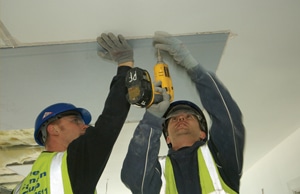FPDC’s technical consultant Steve Halcrow takes a look at making sure that installers use the correct fixings.
 Often through the technical page of Specfinish I talk to FPDC members about drywall and ceiling systems of one kind or another. In these articles we usually concern ourselves with whether or not we are using the right metal stud or channel, or should a particular type of board should be used with certain metal framing components.
Often through the technical page of Specfinish I talk to FPDC members about drywall and ceiling systems of one kind or another. In these articles we usually concern ourselves with whether or not we are using the right metal stud or channel, or should a particular type of board should be used with certain metal framing components.
What we tend to gloss over, however, is the matter of the fixings that hold everything together. All those various screws, clips and wires, which hold together the skeleton of the system and ultimately attach the whole thing to the surrounding structure. Are they really that important? A screw is a screw, isn’t it.
Possibly yes, but what you need to consider is this: what is the job the fixing in question is doing? If for instance it is an anchor which holds a suspended ceiling to the concrete soffit, it is imperative that you check you are using the correct item and that it is approved for the purpose by its manufacturer. In the case of ceilings, we tend to habitually assume that ‘metal knock-ins’ are the answer every time, but beware, they may not be.
Where we fix tracks to structure in constructing partitions, in my experience, a degree of complacency can creep in. Once again it is tempting to think that we are ‘only fixing to a bit of concrete’ and that it’s something we’ve done a million times before. But have we checked that we are using the correct type and length of fixing for the required penetration depth? Do we always make sure we observe the correct edge distances to avoid blowing the concrete? If it’s a shot-fired or gas gun fixing have we definitely got the right nail for the purpose? Does the manufacturer of the partition system in question make any specific recommendations regarding what we should or should not use to fix the tracks?
Remember that these systems are tested for, among other things, fire and acoustic performance. When the performance information for the system is published it is on the basis that the tested system worked successfully, and that system includes its various screws and other components. Using something other than the tested component may open up a risk that you may not have a system covered by the test certification.
This is not to say that you cannot necessarily have a free choice of fixing. It’s more that you must make sure you do so having considered all the options and implications of that choice.
Fixing partition head and base tracks using an established brand of fixing with appropriate back-up to show it is fit for purpose carries minimal risk might be one example. Hanging a suspended ceiling from nylon nailable plugs from a mystery source might be at the other end of the scale!
Check first in every case. Make sure you are well covered so that YOU don’t end up in a fix!


